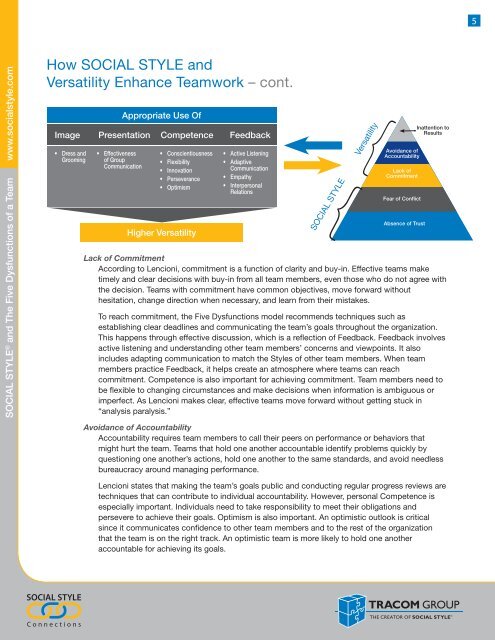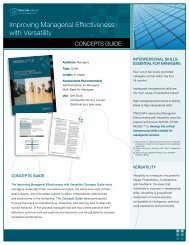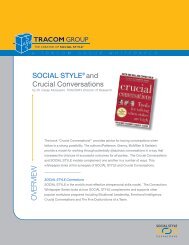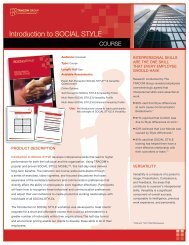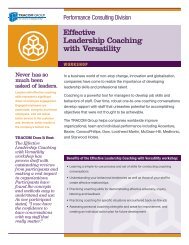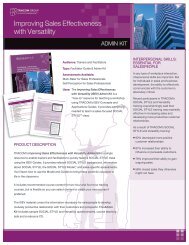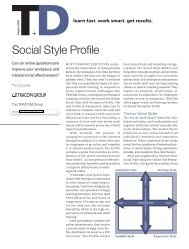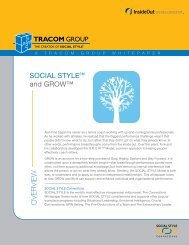Social Style and Five Dysfunctions Whitepaper - The TRACOM Group
Social Style and Five Dysfunctions Whitepaper - The TRACOM Group
Social Style and Five Dysfunctions Whitepaper - The TRACOM Group
Create successful ePaper yourself
Turn your PDF publications into a flip-book with our unique Google optimized e-Paper software.
www.socialstyle.com<br />
SOCIAL STYLE ® <strong>and</strong> <strong>The</strong> <strong>Five</strong> <strong>Dysfunctions</strong> of a Team<br />
How SOCIAL STYLE <strong>and</strong><br />
Versatility Enhance Teamwork – cont.<br />
SOCIAL STYLE<br />
C onnections<br />
Appropriate Use Of<br />
Image Presentation Competence Feedback<br />
• Dress <strong>and</strong><br />
Grooming<br />
• Effectiveness<br />
of <strong>Group</strong><br />
Communication<br />
• Conscientiousness<br />
• Flexibility<br />
• Innovation<br />
• Perseverance<br />
• Optimism<br />
Higher Versatility<br />
• Active Listening<br />
• Adaptive<br />
Communication<br />
• Empathy<br />
• Interpersonal<br />
Relations<br />
{<br />
SOCIAL STYLE Versatility<br />
Avoidance of<br />
Accountability<br />
Lack of<br />
Commitment<br />
Fear of Conflict<br />
Absence of Trust<br />
Inattention to<br />
Results<br />
Lack of Commitment<br />
According to Lencioni, commitment is a function of clarity <strong>and</strong> buy-in. Effective teams make<br />
timely <strong>and</strong> clear decisions with buy-in from all team members, even those who do not agree with<br />
the decision. Teams with commitment have common objectives, move forward without<br />
hesitation, change direction when necessary, <strong>and</strong> learn from their mistakes.<br />
To reach commitment, the <strong>Five</strong> <strong>Dysfunctions</strong> model recommends techniques such as<br />
establishing clear deadlines <strong>and</strong> communicating the team’s goals throughout the organization.<br />
This happens through effective discussion, which is a reflection of Feedback. Feedback involves<br />
active listening <strong>and</strong> underst<strong>and</strong>ing other team members’ concerns <strong>and</strong> viewpoints. It also<br />
includes adapting communication to match the <strong>Style</strong>s of other team members. When team<br />
members practice Feedback, it helps create an atmosphere where teams can reach<br />
commitment. Competence is also important for achieving commitment. Team members need to<br />
be flexible to changing circumstances <strong>and</strong> make decisions when information is ambiguous or<br />
imperfect. As Lencioni makes clear, effective teams move forward without getting stuck in<br />
“analysis paralysis.”<br />
Avoidance of Accountability<br />
Accountability requires team members to call their peers on performance or behaviors that<br />
might hurt the team. Teams that hold one another accountable identify problems quickly by<br />
questioning one another’s actions, hold one another to the same st<strong>and</strong>ards, <strong>and</strong> avoid needless<br />
bureaucracy around managing performance.<br />
Lencioni states that making the team’s goals public <strong>and</strong> conducting regular progress reviews are<br />
techniques that can contribute to individual accountability. However, personal Competence is<br />
especially important. Individuals need to take responsibility to meet their obligations <strong>and</strong><br />
persevere to achieve their goals. Optimism is also important. An optimistic outlook is critical<br />
since it communicates confidence to other team members <strong>and</strong> to the rest of the organization<br />
that the team is on the right track. An optimistic team is more likely to hold one another<br />
accountable for achieving its goals.<br />
{<br />
5


